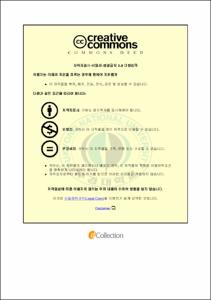조선시대 기로연 기물연구
- Alternative Title
- A Study on the Ware of Giroyeon in Joseon Dynasty Era
- Abstract
- A Study on the Ware of Giroyeon in Joseon Dynasty Era
Young Rang Cha
Department of History, The Graduate School,
Pukyong National University
Abstract
The purpose of this thesis is to consider its historical background and content in studying the ware used for the Joseon Dynasty royal ritual Giroyeon through the background and situation of the Joseon Dynasty feast festival, and further it is to be used as the study materials. In the study method, based on the literature record, citations from other sources in papers, and court paintings, this writer took a look at the procedure of Giroyeon and its ware introduced through Gukjo-oryeui(Five Rites of the State; a manual for national courtesy and ceremonies), Uigwe: The Royal Protocols of the Joseon Dynasty, Yangchonjip(Collected Works of Yangchon), Jukchanghanhwa(The Annals of the Joseon Dynasty), etc. The study purpose and direction were focused on the importance of the revival of ware and its range of practical use in the ware study for historical experience and Cultural Heritage conservation.
Giroyeon seems that the scale and category of a feast differed according to a king's volition and financial condition in each period. Particularly, the silver cups written in Sagiroso(賜耆老所; Gift of Kings to Giroso) that King Sukjong bestowed for his subjects, caused a big issue regarding the study on the ware of Giroyeon. Based on it, the silver cup was reproduced, while the silver teakettle, Sugonghwa(the flower on an official hat bestowed by a king), Sanghwa(the flower on food on the table), etc. were reproduced or restored. In addition to these, , , , etc., such as are precious reproductions based on traditional culture. It seems to be the project to regard highly as the contents industry and our finances including the function of true cultural contents.
In the Joseon Dynasty based on manners as a national policy, the Giroyeon included in Garye under Gukjo-oryeui was a royal ritual that treated those who did meritorious deeds for the state with exceptional respect, which was a royal feast given for old men with learning and virtue. To treat the elderly civil officials (above the senior grade of the 2nd court rank and over 70 years old) with exceptional respect, Giroyeon as a big feast was regularly held on March 3rd and September 9th in the lunar calendar, which was a royal ritual and beautiful social welfare policy. In the early period of the Joseon Dynasty, when King Taejo(Yi, Seong-gye) became sixty years old in 1394, he established Giroso(The Superannuation Office) for Giroyeon as a feast that treated the elderly dignitaries including himself, with exceptional respect. At first, the names of senior contributors (above the senior grade of the 2nd court rank and about 70 years old) were on the list regardless of whether they are civil officials or officials, free prizes are bestowed from the court, and a feast was held mingling with the king and his subjects. Later, from the middle of the Joseon Dynasty the feast was given only to the civil officials who did meritorious deeds for the state and were over 70 years old. King Heonjong bestowed the gwejang(both a folding chair with back and a cane made of goosefoot) on Yi, Gyeong-seok (1595~1671) positioned as Yeongjungchubusa(the senior grade of the 1st court rank) as well, which followed the previous example that a king bestowed a cane or a palanquin when a senior minister over 70 years old asked him to retire from the government post. The introduced vessels, chaehwa(artificial flowers made of dyed silk or ramie fabric, used for a royal court feast), music, jeongjae(dancing to the content of a royal court feast), etc. formed a feast.
Traditional culture is the spiritual basis and power of the race. The Giroyeon based on respecting elders and filial duty, is a beautiful event that expresses the good public morality in Korea. At this point that respect and filial duty have been weakening, needs for education that we see and realize through it were identified. Through this study, I could take a look at its value from both Ye Culture(Korean manners and etiquettes) and the beautiful ware introduced in Joseon Dynasty Era. I intended to study focusing on such point of view.
- Issued Date
- 2015
- Awarded Date
- 2015. 2
- Type
- Dissertation
- Publisher
- 국립부경대학교 대학원 사학과
- Alternative Author(s)
- Cha, Young Rang
- Affiliation
- 국립부경대학교 대학원
- Department
- 대학원 사학과
- Advisor
- 신명호
- Table Of Contents
- 목 차
초 록
1. 머리말 1
Ⅱ. 기로연 3
1. 역사적 배경 3
2. 문헌에 나타난 기로회의 모습 8
3. 기로소의 기능 15
4. 기로연의 절목 18
5. 음악과 정재 25
Ⅲ. 기물연구 28
1. 궁중기록화를 중심으로 28
2. 기물 및 재현 41
3. 재현의 가치와 문화콘텐츠 56
Ⅳ. 맺음말 57
• 참고문헌 59
- Degree
- Master
- Files in This Item:
-
-
Download
 조선시대 기로연 기물연구.pdf
기타 데이터 / 12.48 MB / Adobe PDF
조선시대 기로연 기물연구.pdf
기타 데이터 / 12.48 MB / Adobe PDF
-
Items in Repository are protected by copyright, with all rights reserved, unless otherwise indicated.